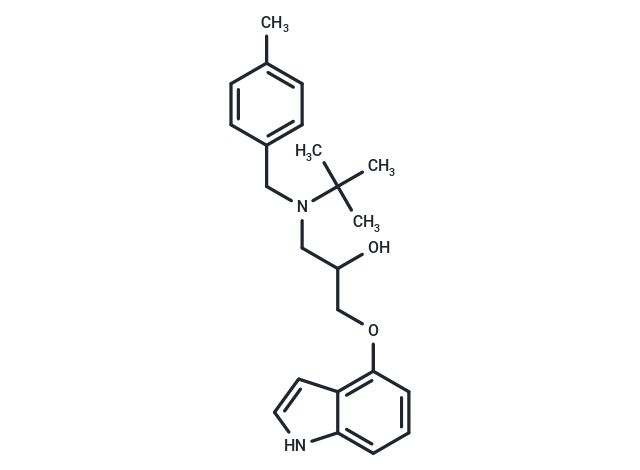购物车
- 全部删除
 您的购物车当前为空
您的购物车当前为空

SR-18292 是一种 PPARγ 共激活因子-1α (PGC-1α) 抑制剂,可增加 PGC-1α 乙酰化,抑制糖异生基因表达并减少肝细胞中的葡萄糖生成。


为众多的药物研发团队赋能,
让新药发现更简单!
SR-18292 是一种 PPARγ 共激活因子-1α (PGC-1α) 抑制剂,可增加 PGC-1α 乙酰化,抑制糖异生基因表达并减少肝细胞中的葡萄糖生成。
| 规格 | 价格 | 库存 | 数量 |
|---|---|---|---|
| 1 mg | ¥ 235 | 现货 | |
| 2 mg | ¥ 333 | 现货 | |
| 5 mg | ¥ 543 | 现货 | |
| 10 mg | ¥ 796 | 现货 | |
| 25 mg | ¥ 1,490 | 现货 | |
| 50 mg | ¥ 2,620 | 现货 | |
| 100 mg | ¥ 4,390 | 现货 | |
| 500 mg | ¥ 9,480 | 现货 | |
| 1 mL x 10 mM (in DMSO) | ¥ 642 | 现货 |
| 产品描述 | SR-18292 is an inhibitor of PPAR gamma coactivator-1α (PGC-1α), which increases PGC-1α acetylation, suppresses gluconeogenic gene expression and reduces glucose production in hepatocytes. |
| 靶点活性 | PGC1α:NA |
| 体外活性 | 转录共激活因子PGC-1α在能量平衡中发挥关键作用,通过共激活调控脂肪和葡萄糖代谢的转录因子。SR-18292增强了PGC-1α与乙酰转移酶GCN5的相互作用,并减少了PGC-1α对核激素受体HNF4α的共激活。SR-18292抑制了HNF4α/PGC-1α的糖异生转录功能。通过增加GCN5与PGC-1α的相互作用,SR-18292增加了PGC-1α特定赖氨酸残基的乙酰化,这可能进一步降低其糖异生活性。 |
| 体内活性 | SR-18292可降低空腹血糖水平、提高肝脏胰岛素敏感性并改善糖尿病小鼠的葡萄糖稳态。采用高脂饮食(HFD)饲养的小鼠,作为肥胖和2型糖尿病(T2D)的饮食模型,通过腹腔注射SR-18292(45 mg/kg),连续3天治疗,并在第4天前再次进行,以测量空腹血糖。结果令人瞩目,SR-18292处理的小鼠与匹配的安慰剂对照小鼠相比,其空腹血糖浓度显著降低。空腹反应调控中,诱导糖异生基因表达是重要组成部分。值得注意的是,来自接受SR-18292治疗的小鼠肝脏中,特别是Pck1的糖异生基因表达受到抑制。 |
| 激酶实验 | For determination of GCN5 HAT activity U-2 OS cells overexpressing Ad-GCN5 are treated with SR-18292 (10 μM) for 18 h. Cells are lysed with buffer B (20 mM HEPES-KOH (pH 7.9), 125 mM NaCl, 1 mM EDTA, 1 mM DTT, 1% IGEPAL (v/v), 10% glycerol (v/v), 5 mM NaF, 5 mM β-glycerophosphate, 5 mM sodium butyrate and 10 mM nicotinamide), supplemented with Protease Inhibitor Cocktail. FLAG-GCN5 is immunoprecipitated with FLAG beads overnight at 4°C following multiple washes with lysis buffer. GCN5 is then eluted using 3× FLAG peptide and the purified protein is used to determine HAT activity using the HAT Inhibitor Screening Assay Kit |
| 细胞实验 | For cell viability determination using MTT, primary hepatocytes are seeded on a 96-well plate at 20,000 cells/well. The following day cells are treated at different doses, as indicated, for 18 h treatment of primary hepatocytes. 5 μL of MTT reagent (5 mg/mL) is then added to each well (n=4/dose) and cells are incubated for 1h at 37°C. Medium is discarded and dye is extracted by adding 100 μL DMSO to each well. For cytotoxicity determination using ToxiLight Non-destructive Cytotoxicity Bioassay, hepatocytes are seeded on a 6-well plate and treated with either SR-18292 (20 μM) or Cisplatin (50 μM) for 18 h. 50 μL of medium is collected and used to measure cellular toxicity by adding 100 of adenylate kinase detection reagent and incubating 5 min at RT before measuring luminescence[ |
| 动物实验 | SR-18292 is re-suspended in a 10% DMSO/10% Tween80/80% PBS solution at a final concentration of 6-12 mg/mL.MiceFor in vivo studies with DIO mice, males 6-8 weeks old are fed high fat diet (HFD) for the indicated time. For drug administration, SR-18292 (45 mg/kg) is injected via I.P. for 3 days between 4-5 pm and food is removed on day 3 at 5pm. The following morning (day 4) SR-18292 is injected again (for a total of 4 injections) and blood glucose is measured after 3 hours. Injection volume does not exceed 275 μL per mouse |
| 别名 | SR 18292 |
| 分子量 | 366.5 |
| 分子式 | C23H30N2O2 |
| CAS No. | 2095432-55-4 |
| Smiles | Cc1ccc(CN(CC(O)COc2cccc3[nH]ccc23)C(C)(C)C)cc1 |
| 密度 | 1.132 g/cm3 (Predicted) |
| 存储 | store at low temperature | Powder: -20°C for 3 years | In solvent: -80°C for 1 year | Shipping with blue ice. | |||||||||||||||||||||||||||||||||||
| 溶解度信息 | Ethanol: 10 mg/mL DMSO: 55 mg/mL (150.06 mM) H2O: Insoluble | |||||||||||||||||||||||||||||||||||
溶液配制表 | ||||||||||||||||||||||||||||||||||||
| ||||||||||||||||||||||||||||||||||||
评论内容